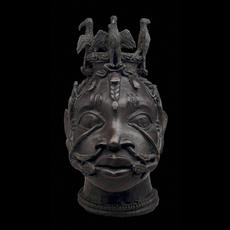
 |
|
|||||||||||||||||||||||||||||||||||||||||||||||||
 |
The Story Behind the Myths Whether Oduduwa was a migrant or a political adventurer, his arrival was a significant milestone in the history of the Yoruba people. The rise of Ile-Ife was due to the dynamic personality of the man. Whatever his origin it is clear from tradition that he struggled for political leadership in Yorubaland.
|
In another story recorded in tradition, Oduduwa's struggle for power is presented as a contest for hegemony between the people of Ile-Ife and another group known to be Yoruba speaking, called the Ugboh. It is reasonable to assume that Oduduwa was the leader of the Ife people at that time, judging from the details of the events and some of the personalities involved in the episode. In this contest the Ife people triumphed, through the exploits of a very beautiful and politically sagacious woman called Moremi. These stories considered together reveal that Oduduwa not only had to struggle for leadership but also had to lead the peoples in withstanding and overcoming aggression of some powerful neighbours who were bent on destroying the nascent kingdoms of Ife.
The Achievements of Oduduwa
To begin with, tradition is positive that the monarchical system of government which characterized political organizations in Yorubaland was begum by Oduduwa. Either in his mythical role as the emissary of Oludamare on Earth or in his more real role as the leader of a migrant group or an emerging elite, Oduduwa is regarded as the first King of Ile-Ife. There is also evidence in tradition that after his death the monarchical system he established was continued. Names of Oduduwa's successors to the throne of Ile-Ife survive in tradition in varying forms. Also from the time of Oduduwa, Ile-Ife became famous as the centre of Yoruba religion. The essence of this religion is the belief in and worship of one supreme being called Olodumare and the recognition of a number of deities serving as intermediaries between Him and man. Both Olodumare and these deities are believed to have had their first contacts with man at Ile-Ife. Finally, there was the remarkable achievements in the field of art. The works of art which have made Ile-Ife famous comprise largely bronze and terra cotta sculptures dating back to the tenth and eleventh centuries A.D. The works have gathered so much praise that noted European anthropologist have compared the works with those of Ancient Egypt, Classical Greece and even Renaissance Europe. Some of these beautiful works are displayed all through the website for people to appreciate. Originally these works of art were at Ile-Ife were not believed to of African origin. Not until thorough investigations was undertaken were the works finally accepted as products of a civilization in Ife itself made during the period of Yoruba history. In addition to the terra cottas and bronzes, there are also a number of stone monuments and other objects found in and around Ile-Ife. These consist of monoliths, carved figures of human beings and animals, as well as decorated tools. The most significant of these is the six metre high granite column known as the Opa Oranyan (staff of Oranyan). The Opa is said to mark the grave of Oranyan, believed to be the son or grandson of Oduduwa. But no burial pits have been found in its vicinity. It has been alternatively suggested that the Opa was originally dedicated to Ogun, the god of iron and war. Whatever its original purpose, the Opa is a remarkable work of art.
|